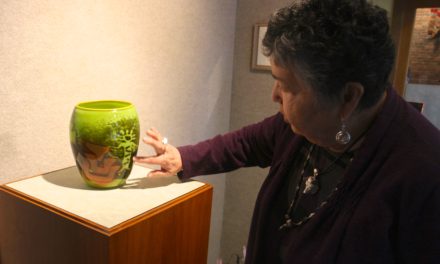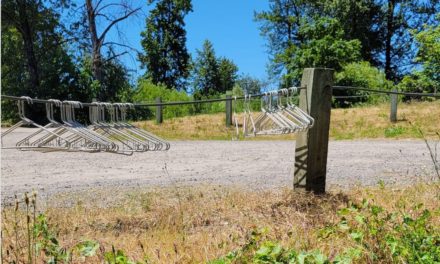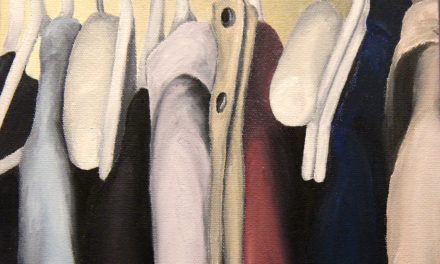(The Vessel Needn’t Move is one of the late Rick Bartow’s complex works of art, part of the Myth/Reality exhibit at the Karin Clarke Gallery.)
By Randi Bjornstad
Many exhibits featuring the work of Native American artist Rick Bartow have appeared on the walls at the Karin Clarke Gallery in downtown Eugene, not to mention many other shows nationally, ranging from the University of Oregon to the Smithsonian Institution’s National Museum of the American Indian in Washington, D.C.
But showing Bartow’s work again and again perhaps has its greatest resonance in Oregon because he spent much of his life in the Newport area.

Masking, by Native American/Oregonian artist Rick Bartow (1946-2016)
The latest is one called Myth/Reality that opened at the Karin Clarke Gallery in April and runs through May 13.
“A wide range of cultural and life experiences inspired Rick Bartow’s drawings, paintings, sculpture, and prints,” Clarke said in introducing this latest show. “Native American transformation myths are the heart of much of his work — Bartow lived and worked on the Oregon coast, where he observed hawks, ravens, eagles, and crows, among the subjects that populate his artwork.”
She worked closely with the Bartow Trust to select a wide range of works that make this exhibit “what we feel is one of his best shows yet, (including) large acrylic paintings on canvas, his signature powerful pastel drawings, monotypes, drypoint prints, and sculpture,” she said.
The Rick Bartow story
The Eugene Scene has written several stories about Bartow — both his history and his art — through the years. Here are some excerpts that help tell the story of his life and talent:
- Bartow was a member of the Wiyot tribe from Northwestern California. In 1860, his tribe fell victim to a massacre near Eureka, in Humboldt County. Hostility had been growing for years when the white settlers who had come west with the Gold Rush began encroaching on traditional tribal lands with cattle-grazing and town- building. One night, it turned deadly when settlers attacked the Wiyots, killing somewhere between 80 and 250 people, including women, children, and tribal elders.
- That painful history affected his life and his art, but he also experienced other direct tragedies and challenges. He served in the Vietnam War and developed post-traumatic stress disorder. He was a recovering alcoholic. His wife died of breast cancer.
- Besides drawing, painting, sculpture and ceramics, Bartow also was a guitarist, singer, and songwriter.
- In 2013, three years before his death at age 69, he suffered a severe stroke which disrupted many of his cognitive and motor skills, which he had to relearn or rediscover. He lost speech and for some time could only voice what he called “yabba yabba,” describing those losses as “having my brain dented.”
- He regained hope for recovery one day in the hospital when a nurse left a pen on a bedside stand, where there also was a paper napkin. He picked up the pen and drew a bird on the napkin and suddenly “knew everything was going to be okay.”
Clarke considers Rick Bartow to be “one of the most important artists to come out of Oregon.”
“I always had the impression that he didn’t have a big ego — he was just doing what he was and what he needed to be,” she said. “I think he may be the most-asked-about artist of anyone whose work I have ever shown.”
Myth/Reality at the Karin Clarke Gallery
When: Through May 13, 2023
Where: Karin Clarke Gallery, 760 Willamette St., Eugene
Hours: Noon to 5:30 p.m., Wednesday through Friday; 10 a.m. to 4 p.m. Saturday
Information: 541-684-7963 or karinclarkegallery.com








